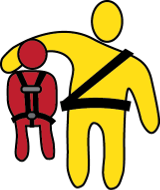


Recommendations for each stage* Birth to 13 years old, in the back seat* Birth to as close to four years old as possible: rear facing infant or convertible carseat * Roughly four years to about the sixth birthday: forward face with harness and top tether * Six to 12 years old: use a booster seat as long as the child fits * Over 13: seatbelt anywhere in the car https://www.nhtsa.gov/equipment/car-seats-and-booster-seats#age-size-rec FlyingThe FAA recommends that all children ride in a carseat from birth to roughly 40 pounds on board a plane. They very strongly are against lap babies."Did you know that the safest place for your child on an airplane is in a government-approved child safety restraint system (CRS) or device, not on your lap? Your arms aren't capable of holding your child securely, especially during unexpected turbulence. The Federal Aviation Administration (FAA) strongly urges you to secure your child in a CRS or device for the duration of your flight. It's the smart and right thing to do so that everyone in your family arrives safely at your destination. The FAA is giving you the information you need to make informed decisions about your family's travel plans." http://www.faa.gov/passengers/fly_children/ Many international airlines respect US aircraft approval stickers, however, check on their regulations and requirements for rear versus forward facing, and age allowed for use of a seat on board. School BusesSchool buses are nearly eight times safer than a child riding in a personal vehicle in a proper restraint. Provided the child sits properly for the entirety of the ride, they are very safe, even without seatbelts on board.http://www.nhtsa.gov/Research/Crashworthiness/School+Bus+Crashworthiness+Research
|
©2020 by Wendy Tischler Thomas 